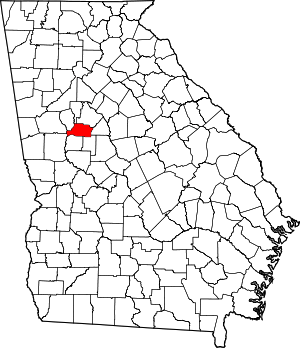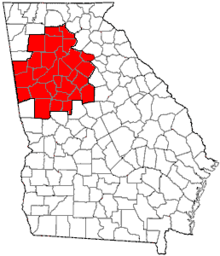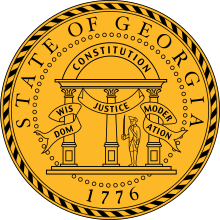Spalding County, Georgia
Spalding County is a county located in the west central portion of the U.S. state of Georgia. As of the 2010 census, the population was 64,073.[2] The county seat is Griffin.[3] The county was created December 20, 1851 and named for former United States representative and senator Thomas Spalding.[4]
Spalding County | |
|---|---|
Spalding County Courthouse in Griffin | |
 Location within the U.S. state of Georgia | |
 Georgia's location within the U.S. | |
| Coordinates: 33°16′N 84°17′W | |
| Country | |
| State | |
| Founded | 1851 |
| Named for | Thomas Spalding |
| Seat | Griffin |
| Largest city | Griffin |
| Area | |
| • Total | 200 sq mi (500 km2) |
| • Land | 196 sq mi (510 km2) |
| • Water | 3.1 sq mi (8 km2) 1.6%% |
| Population | |
| • Estimate (2018) | 66,100[1] |
| • Density | 326/sq mi (126/km2) |
| Time zone | UTC−5 (Eastern) |
| • Summer (DST) | UTC−4 (EDT) |
| Congressional district | 3rd |
| Website | www |
Spalding County is included in the Atlanta-Sandy Springs-Roswell, GA Metropolitan Statistical Area.
Geography
According to the U.S. Census Bureau, the county has a total area of 200 square miles (520 km2), of which 196 square miles (510 km2) is land and 3.1 square miles (8.0 km2) (1.6%) is water.[5] The county is located in the Piedmont region of the state.
The western portion of Spalding County, west of a line from Sunny Side through Griffin to Orchard Hill, is located in the Upper Flint River sub-basin of the ACF River Basin (Apalachicola-Chattahoochee-Flint River Basin). The eastern part of the county is located in the Upper Ocmulgee River sub-basin of the Altamaha River basin.[6]
Major highways














Adjacent counties
- Henry County (northeast)
- Butts County (east)
- Lamar County (southeast)
- Pike County (southwest)
- Meriwether County (west)
- Coweta County (west)
- Fayette County (northwest)
- Clayton County (northwest)
Demographics
| Historical population | |||
|---|---|---|---|
| Census | Pop. | %± | |
| 1860 | 8,699 | — | |
| 1870 | 10,205 | 17.3% | |
| 1880 | 12,585 | 23.3% | |
| 1890 | 13,117 | 4.2% | |
| 1900 | 17,619 | 34.3% | |
| 1910 | 19,741 | 12.0% | |
| 1920 | 21,908 | 11.0% | |
| 1930 | 23,495 | 7.2% | |
| 1940 | 28,427 | 21.0% | |
| 1950 | 31,045 | 9.2% | |
| 1960 | 35,404 | 14.0% | |
| 1970 | 39,514 | 11.6% | |
| 1980 | 47,899 | 21.2% | |
| 1990 | 54,457 | 13.7% | |
| 2000 | 58,417 | 7.3% | |
| 2010 | 64,073 | 9.7% | |
| Est. 2018 | 66,100 | [7] | 3.2% |
| U.S. Decennial Census[8] 1790-1960[9] 1900-1990[10] 1990-2000[11] 2010-2013[2] | |||
2000 census
As of the census[12] of 2000, there were 58,417 people, 21,519 households, and 15,773 families living in the county. The population density was 295 people per square mile (114/km²). There were 23,001 housing units at an average density of 116 per square mile (45/km²). The racial makeup of the county was 66.50% White, 31.05% Black or African American, 0.23% Native American, 0.67% Asian, 0.02% Pacific Islander, 0.65% from other races, and 0.88% from two or more races. 1.62% of the population were Hispanic or Latino of any race.
There were 21,519 households out of which 34.00% had children under the age of 18 living with them, 50.30% were married couples living together, 18.20% had a female householder with no husband present, and 26.70% were non-families. 22.30% of all households were made up of individuals and 8.50% had someone living alone who was 65 years of age or older. The average household size was 2.67 and the average family size was 3.12.
In the county, the population was spread out with 27.30% under the age of 18, 9.20% from 18 to 24, 29.40% from 25 to 44, 22.50% from 45 to 64, and 11.70% who were 65 years of age or older. The median age was 35 years. For every 100 females, there were 93.20 males. For every 100 females age 18 and over, there were 88.90 males.
The median income for a household in the county was $36,221, and the median income for a family was $41,631. Males had a median income of $32,347 versus $22,114 for females. The per capita income for the county was $16,791. About 12.40% of families and 15.50% of the population were below the poverty line, including 21.30% of those under age 18 and 11.30% of those age 65 or over.
2010 census
As of the 2010 United States Census, there were 64,073 people, 23,565 households, and 16,869 families living in the county.[13] The population density was 326.1 inhabitants per square mile (125.9/km2). There were 26,777 housing units at an average density of 136.3 per square mile (52.6/km2).[14] The racial makeup of the county was 62.7% white, 32.8% black or African American, 0.9% Asian, 0.3% American Indian, 0.1% Pacific islander, 1.6% from other races, and 1.6% from two or more races. Those of Hispanic or Latino origin made up 3.8% of the population.[13] In terms of ancestry, 23.3% were American, 7.6% were Irish, and 6.9% were English.[15]
Of the 23,565 households, 36.2% had children under the age of 18 living with them, 46.3% were married couples living together, 19.4% had a female householder with no husband present, 28.4% were non-families, and 23.5% of all households were made up of individuals. The average household size was 2.67 and the average family size was 3.12. The median age was 37.2 years.[13]
The median income for a household in the county was $41,100 and the median income for a family was $49,640. Males had a median income of $37,976 versus $30,684 for females. The per capita income for the county was $19,607. About 17.2% of families and 21.2% of the population were below the poverty line, including 30.4% of those under age 18 and 14.0% of those age 65 or over.[16]
Education
The Griffin-Spalding County School District has 11 elementary schools, 4 middle schools, 2 high schools, and 4 complementary programs.
Communities
Cities
Town
Census-designated places
Politics
| Year | Republican | Democratic | Third parties |
|---|---|---|---|
| 2016 | 60.9% 15,646 | 36.4% 9,357 | 2.7% 701 |
| 2012 | 59.3% 14,911 | 39.4% 9,898 | 1.3% 330 |
| 2008 | 58.9% 14,885 | 40.1% 10,141 | 1.1% 269 |
| 2004 | 64.0% 13,461 | 35.5% 7,460 | 0.6% 115 |
| 2000 | 60.2% 9,271 | 37.9% 5,831 | 1.9% 289 |
| 1996 | 50.7% 7,376 | 41.4% 6,017 | 7.9% 1143 |
| 1992 | 46.2% 7,262 | 40.6% 6,392 | 13.2% 2080 |
| 1988 | 63.7% 7,730 | 35.6% 4,318 | 0.7% 90 |
| 1984 | 63.7% 8,571 | 36.3% 4,878 | |
| 1980 | 39.0% 4,809 | 58.2% 7,176 | 2.8% 346 |
| 1976 | 33.0% 3,739 | 67.0% 7,593 | |
| 1972 | 80.8% 7,183 | 19.2% 1,702 | |
| 1968 | 28.0% 3,077 | 26.9% 2949 | 45.1% 4,953 |
| 1964 | 46.6% 4,763 | 53.4% 5,466 | |
| 1960 | 28.4% 1,753 | 71.6% 4,426 | |
| 1956 | 23.1% 1,458 | 76.9% 4,853 | |
| 1952 | 19.1% 1,249 | 80.9% 5,296 | |
| 1948 | 14.5% 671 | 74.4% 3,441 | 11.1% 514 |
| 1944 | 7.2% 217 | 92.8% 2,805 | 0.0% 1 |
| 1940 | 6.1% 197 | 93.8% 3,022 | 0.1% 4 |
| 1936 | 1.4% 36 | 98.3% 2,457 | 0.3% 7 |
| 1932 | 2.4% 54 | 97.1% 2,185 | 0.5% 12 |
| 1928 | 19.2% 412 | 80.8% 1,734 | |
| 1924 | 5.3% 75 | 88.5% 1,257 | 6.2% 88 |
| 1920 | 17.9% 181 | 82.1% 830 | |
| 1916 | 14.8% 152 | 81.2% 835 | 4.0% 41 |
| 1912 | 5.6% 45 | 91.2% 736 | 3.2% 26 |
References
- "Population and Housing Unit Estimates". U.S. Census Bureau. July 31, 2019. Retrieved July 31, 2019.
- "State & County QuickFacts". United States Census Bureau. Retrieved June 26, 2014.
- "Find a County". National Association of Counties. Retrieved June 7, 2011.
- Krakow, Kenneth K. (1975). Georgia Place-Names: Their History and Origins (PDF). Macon, GA: Winship Press. p. 209. ISBN 0-915430-00-2.
- "US Gazetteer files: 2010, 2000, and 1990". United States Census Bureau. February 12, 2011. Retrieved April 23, 2011.
- "Georgia Soil and Water Conservation Commission Interactive Mapping Experience". Georgia Soil and Water Conservation Commission. Retrieved November 20, 2015.
- "Population and Housing Unit Estimates". Retrieved July 31, 2019.
- "U.S. Decennial Census". United States Census Bureau. Retrieved June 26, 2014.
- "Historical Census Browser". University of Virginia Library. Retrieved June 26, 2014.
- "Population of Counties by Decennial Census: 1900 to 1990". United States Census Bureau. Retrieved June 26, 2014.
- "Census 2000 PHC-T-4. Ranking Tables for Counties: 1990 and 2000" (PDF). United States Census Bureau. Retrieved June 26, 2014.
- "U.S. Census website". United States Census Bureau. Retrieved January 31, 2008.
- "DP-1 Profile of General Population and Housing Characteristics: 2010 Demographic Profile Data". United States Census Bureau. Archived from the original on February 13, 2020. Retrieved December 30, 2015.
- "Population, Housing Units, Area, and Density: 2010 - County". United States Census Bureau. Archived from the original on February 13, 2020. Retrieved December 30, 2015.
- "DP02 SELECTED SOCIAL CHARACTERISTICS IN THE UNITED STATES – 2006-2010 American Community Survey 5-Year Estimates". United States Census Bureau. Archived from the original on February 13, 2020. Retrieved December 30, 2015.
- "DP03 SELECTED ECONOMIC CHARACTERISTICS – 2006-2010 American Community Survey 5-Year Estimates". United States Census Bureau. Archived from the original on February 13, 2020. Retrieved December 30, 2015.
- Leip, David. "Dave Leip's Atlas of U.S. Presidential Elections". uselectionatlas.org. Retrieved March 22, 2018.
External links
| Wikimedia Commons has media related to Spalding County, Georgia. |
- County website
- Spalding County Genealogy
- Doc Holliday (John Henry Holliday) Biography and Photos

